To live on a boat is to experience, and appreciate, a myriad of contrasts. Naturally, we live and breathe the weather, which of course can span a wide range of differences within just a few hours or a few nautical miles. As described in previous posts, we can quickly move from a leisurely journey down a winding river to a narrow canal with warnings to “only transit on a rising tide.” We wake and rush to get an early start only to be halted in our tracks by gusting winds, and then must practice patience as we delay our departure until the winds calm (that’s what happened to us on Day 33).
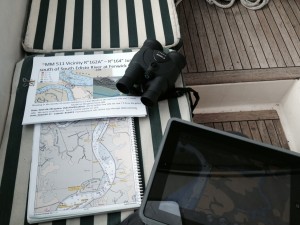
And we debate the choice of anchoring out in a remote creek, or taking refuge at a marina with kindred sailors while enjoying land-based luxuries. Like many things in life, both choices have their merits, and their drawbacks.
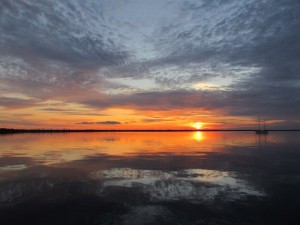
Anchoring is also referred to as living “on the hook.” For those who prefer independence and scenic surroundings, it’s hard to beat anchoring. And it is the preferred choice for many because it’s free in the USA and most places around the world. Marinas in the USA typically charge by the foot, from $1/foot to $3/foot, per night. Our boat is 50 feet long, so you do the math. And you’ll quickly see that staying at too many marinas can put a real dent in our cruising kitty.

Many boaters equip their vessels with gear that enables them to be self-sufficient and therefore not dependent on having to stay at marinas for creature comforts such as energy (power), water, showers, toilets, and laundry. Energy (when not hooked up to shore power via cables) is usually provided through battery banks that store power generated by the engine running all day, and possibly supplemented by wind generators and solar panels. Many sailboats of our size also have generators that can be run when necessary to restore ebbing power in the battery banks, or if heat or air conditioning is needed. Belle Bateau has all of the above, so we can anchor out without sacrificing any creature comforts.
Except a good night’s sleep.
Yep. If weather forecasts call for strong winds or storms, many boaters will head to a marina. Why? Because anchors can drag. And the fear of dragging anchors will put an end to any thoughts of a peaceful night of sleep. We even set an alarm to alert us if our boat moves x feet from where we anchored. And still, that doesn’t guarantee slumber because we cannot be sure that the boats anchored 60 feet upwind from us set their anchors securely. So they can drag and hit us. Or we can drag and hit boats downwind. Or we can drag anchor and be dashed upon rocks, or drag onto a shoal and get stuck in the mud on a falling tide. Yep, a good night’s sleep is tough if strong winds or storms are present.
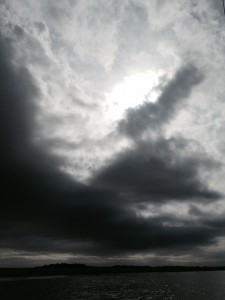
And then there’s the current. Here, in South Carolina, the tides ebb in and they ebb out in a big way, with waters rising and falling 5 to 8 feet, depending on location. That’s a lot of water moving past our boat, and our anchor. We weren’t sure if we wanted to anchor in any creeks with strong current. But we have a fabulous anchor — a Rocna. So we tried a creek with moderate current, and had success. Then graduated ourselves to a creek with high current. And had success.
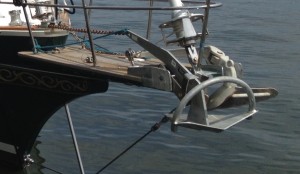
I’m sure I slept like a baby both nights, while Dudley was up a few times checking our position. And it’s quite different than when we anchored in the Chesapeake. There, our boat usually pointed its bow in the direction of the wind, since Chesapeake currents are minimal (or absent altogether). But in South Carolina, boats tend to point their bows into the direction of the current, which means that we might spin 180 degrees when the tides ebb in, and then another 180 when they ebb out. Getting dizzy yet?
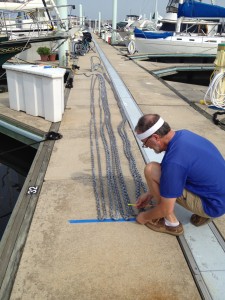
When selecting a creek or cove in which to anchor, we must check the charted depths, and anticipate the tidal differences in the creek as well as at its entrance. We will let out enough chain to achieve perhaps a 1:5 scope, meaning that if we are in 12’ of water, plus the 3’ height to our bowsprit, we’ll let out chain totaling five times that distance, or 75’ (15 x 5). If conditions warrant, we may use a 1:7 scope. We carry 225′ of chain with our Rocna, and a second anchor, a Fortress, with 50′ chain and 250′ of line.
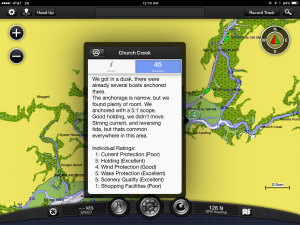
We also consider protection that land may give us, such as trees, hills, or other landscape features that can block forecasted winds and possibly waves from highly trafficked areas. But several times this trip, we’ve anchored in salt marshes where there were no features on land to block a strong breeze. There’s a reason why they call this the Low Country!
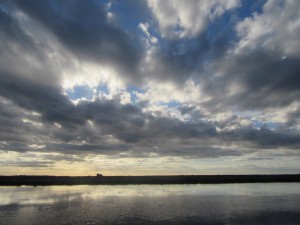
For those who are new to boating and reading these blogs, I should add a note about sailing out in the ocean. You can’t anchor there. Think about it. It’s really really really deep, it’s really rocking and rolling, and there’s nowhere to anchor until you find suitable land with protection from wind and waves. So there is no stopping. The two of us would alternate night watches if we did a long passage requiring sailing at night. We’ve met a few folks on this trip who went out into the ocean to bypass some of the shallow areas of the ICW. Some do a long day, from 5 am to 5 pm before coming back to anchor within the ICW. Others pull a 24-hour passage, which requires sailing at night. We haven’t done ocean sailing yet, together that is. Stay tuned.
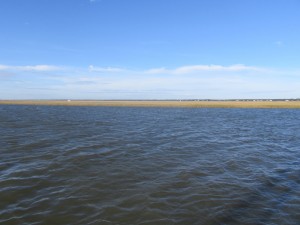
But back to anchoring. Day 33 found us anchored in Church Creek, a strong contrast to the Charleston City Marina that we left earlier that day. From mega yachts to mega marshes, in just four short hours. The current was strong in Church Creek but our Rocna anchor held. We spun 180, and then 180 again. And it still held. And Captain D claims he got a good night’s sleep.
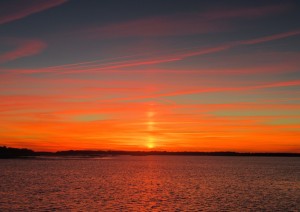
Oh, how peaceful and beautiful it can be when living on the hook. A few times, it’s been just two to three boats anchored quite far from each other in the same creek, respecting privacies. Other times, like in Church Creek, it’s just been us and the dolphins. Under pink and orange skies at sunset. Ah, yes.

Am really enjoying the blog updates and can relate to the balance between “enjoying the moment” each part of the day brings and needing to plan ahead in order to minimize how many times you’ll say “well, we won’t do that again”.
I also appreciated the description of the 1:5 or 1:7 scope for anchoring – reminds me of great but wavy weekends “on the hook” at Laketown Beach off Holland in the summer.
Have a wonderful Thanksgiving – wherever that is this year!!
Thanks Steve! We just arrived Skull Creek Marina on Hilton Head Island for the Thanksgiving holiday. My sons are driving down from NC and friends are hosting all of us for Thanksgiving dinner. I hope you enjoy your break, and thanks for following our journey!